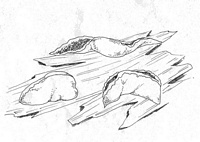|
 Physarum bivalve Physarum bivalve
SynonymsPhysarum sinuosum
Reticularia sinuosa
BiostatusPresent in region - Indigenous. Non endemic
Images (click to enlarge)
Caption: Sessile sporangia of Physarum bivalve. The one on the lower right is about 0.7 mm tall.
Owner: S.L. Stephenson |
Article: Stephenson, S.L. (2003). Myxomycetes of New Zealand. Fungi of New Zealand. Ngā Harore o Aotearoa 3: xiv + 238 p. Hong Kong: Fungal Diversity Press.
Description: Fruiting body a sessile sporangium or plasmodiocarp, gregarious to crowded, laterally compressed, 0.5 mm to 1.0 cm or more long and 0.7–1.0 mm tall. Peridium consisting of two layers, the outer layer usually thickly calcareous and white to dark grey or brownish yellow, the inner layer delicate, membranous, colourless, dehiscence by a more or less regular, preformed longitudinal fissure. Hypothallus membranous, thin, colourless to pale brown, usually inconspicuous. Columella absent. Capillitium dense, consisting of numerous, large, angular, elongated or branching white lime nodes and short connecting filaments. Spores black in mass, dull violet brown by transmitted light, minutely and uniformly warted, 8–10 µm in diameter. Plasmodium grey, pallid, or yellowish.
Habitat: Dead leaves; occasionally occurring on other types of plant debris and also more rarely on bryophytes.
Distribution: Widespread in the Northern Hemisphere and also known from South Africa, the Pacific islands, and Australia (Martin & Alexopoulos 1969). First reported (as Physarum sinuosum) from New Zealand by Rawson (1937), based on a specimen collected in Dunedin. Also known from Nelson and Wellington.
Notes: Typical fruitings of Physarum bivalve almost invariably contain at least some sporangia that resemble minute clams, but the species also can occur as short or long and single to branched plasmodiocarps.
|